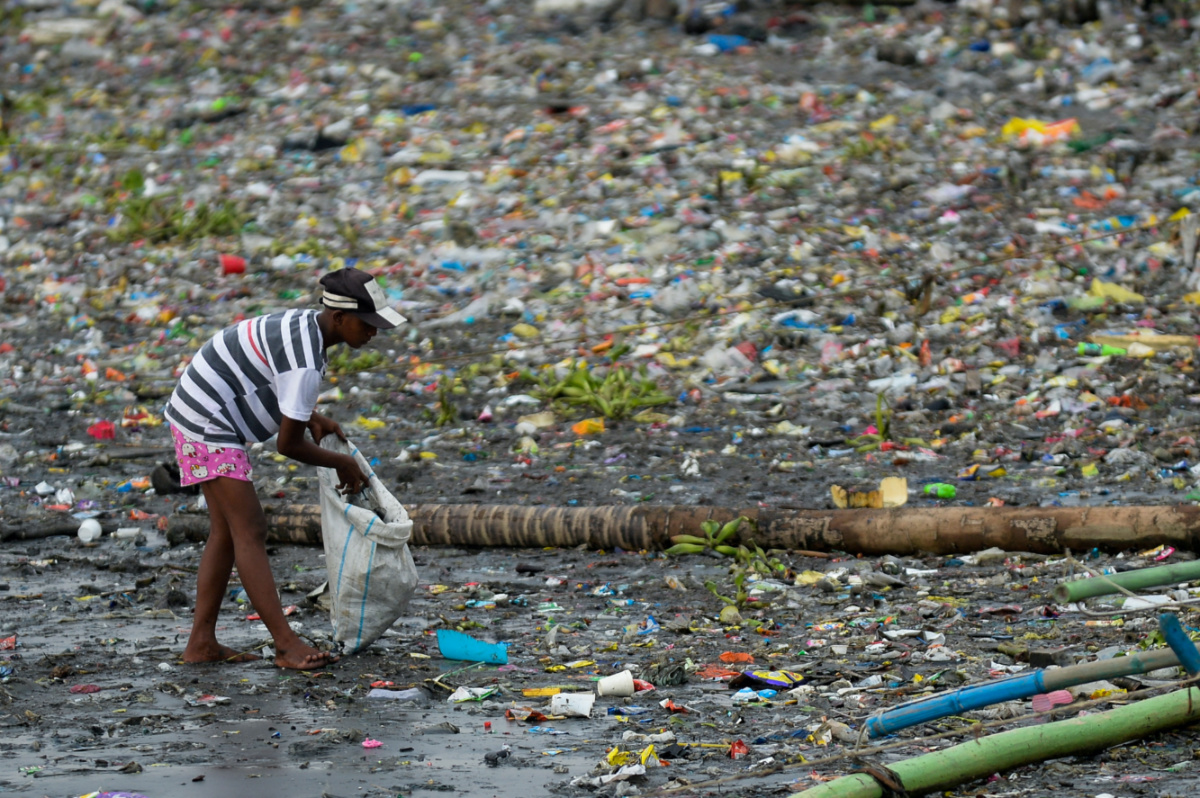From drinks bottles to straws and cotton buds, the amount of plastic waste that flows into the world’s oceans and marine areas is expected to nearly triple by 2040, adding up to 37 million tonnes each year, the UN Environment Programme says.
Just nine per cent of all the plastic waste ever produced has been recycled, while about 12 per cent has been incinerated. The remainder has finished up in landfills, dumps or the environment, according to the UN agency.

A woman picks up plastic cups along the riverbank of Pasig river, in Manila, Philippines, on 10th June, 2021. PICTURE: Reuters/Lisa Marie David/File photo.
In a bid to tackle the growing plastic waste crisis, government officials from around the world is starting talks on a global pact this week at the UN Environment Assembly conference in the Kenyan capital, Nairobi.
It is unclear whether any pact on plastic pollution would be legally binding or voluntary, and whether it would include measures to curb the production of single-use plastic items or focus simply on waste management.
Here’s why the talks on a global treaty – which will also involve businesses and civil society – are seen as vital to protect the environment, human health and the global economy:
Why is plastic waste such a problem, and who’s behind it?
The United States is the biggest per capita producer of plastic waste, but in many developing nations a combination of fast-growing economies and populations and long coastlines have filled local seas with plastic rubbish.
Refuse collection and recycling services have largely failed to keep pace with economic development and increased plastic use over the last four decades, particularly in developing countries.
China – once the world’s biggest importer of plastic waste – halted imports in 2018, prompting many wealthy countries to divert their garbage to other developing nations.
Soon after, containers full of unsorted trash – often mislabelled as plastics for recycling – were shipped to various developing countries, causing diplomatic tension.
Faced with growing stockpiles, some countries ramped up the burning of plastics to produce energy or sent the waste to landfill. Both have a severely damaging impact on the environment, green groups have warned.
Why is a global treaty needed?
From the 1980s on, the world quickly became dependent on single-use or disposable plastic, with half of all plastic produced designed to be used only once and then thrown away – from shampoo bottles to shopping bags.
In the early 2000s, the amount of plastic waste rose more in a single decade than it did in the previous 40 years, according to UNEP, with annual plastic waste now totalling about 300 million tonnes.
Globally, one million plastic drinking bottles are purchased every minute, while five trillion single-use plastic bags are used every year, the UN agency added.
The use of disposable plastic, made from oil and gas, supports the fossil fuel industry and hurts tourism, fishing and shipping industries, according to green groups and economists.
“All evidence suggests that plastic contamination of the ocean is irreversible,” Heike Vesper, director of the marine programme at WWF Germany said in a statement. “Once distributed in the ocean, plastic waste is almost impossible to retrieve.”
The coronavirus pandemic has presented an additional challenge, as single-use plastic consumption has increased during the crisis.
About 75 per cent of plastic generated by the COVID-19 pandemic – such as medical waste and packaging from home deliveries – will likely end up in landfills or the sea, according to UN estimates.
We rely on our readers to fund Sight's work - become a financial supporter today!
For more information, head to our Subscriber's page.
What are countries doing to tackle the problem?
Many nations and cities have introduced bans on single-use plastic items, and improved waste collection and recycling.
Public awareness campaigns have also had an impact on consumer behaviour – such as not using single-use drinking straws, or opting for reusable water bottles and coffee cups – along with incentives for recycling.
Communities living near or in coastal areas have teamed up with businesses to form voluntary groups that collect rubbish that washes up on their shores, hoping to protect nature and vital tourism industries.
Meanwhile, new technologies – like mobile apps and GPS – are also being used to help with urban waste collection and management, often using informal garbage collectors.
Facing increased consumer pressure, big brands have pledged to cut plastic waste, with the likes of Coca Cola and PepsiCo among more than 70 signatories to call for a global pact to combat plastic pollution last month.
What is a circular economy and how can it help?
In a circular economy, waste materials – such as metals, minerals and plastic – are recycled back into new raw materials for a next round of production, reducing rubbish and pollution.
About 70 per cent of planet-heating emissions are related to the production and use of products – from the buildings we live in and the transport we use, to the food we eat and the clothes we wear, according to a report published last month by Amsterdam-based social enterprise Circle Economy.
These emissions are generated by resource extraction, processing and manufacturing of goods, it added.
The report’s authors said nations are missing an opportunity to slash emissions by adopting circular economy policies that reduce demand for resources and could help meet the Paris accord target of limiting global warming to 1.5 degrees Celsius.
Among their suggestions is for countries to use recycled metal and plastics to make vehicles and recycle vehicles.
“Our insatiable demand for resources and throwaway economy is threatening the planet’s future and driving us down the road to climate breakdown,” Martijn Lopes Cardozo, Circle Economy’s chief executive, said in a statement.






